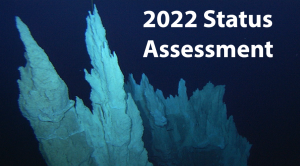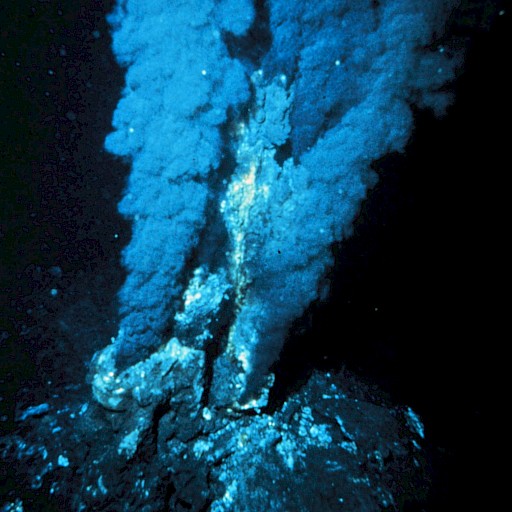Oceanic Ridges with Hydrothermal Vents
Habitat: Oceanic Ridges with Hydrothermal Vents
Description: Hydrothermal vents occur along spreading ridges (such as the mid-Atlantic ridge), fracture zones and back-arc basins. They are produced by seawater penetrating the upper levels of the Earth crust through channels formed in cooling lava flows, reacting chemically with hot basalt inside the crust and then rising back to the sea-bed to vent as superheated water containing compounds such as sulphides, metals, CO2 and methane. Generally hydrothermal vent fields cover relatively small areas of the seabed in water depths of 850–4000 m. However shallower vents can occur between 100 and 500 metres as in Iceland or even as sallow as 20m in the Azores. The biological communities associated with hydrothermal vents are unusual as they are able to derive energy under conditions where photosynthesis is not possible. These habitats contain a huge diversity of chemo-autotrophic bacteria, which form the basis of the trophic structure around the vent. Characteristic species at the deep-sea Mid-Atlantic Ridge vents include the mussels, shrimps, crabs, polychaetes, amphipods and the limpets.
OSPAR Regions where it occurs: I, V
OSPAR Regions where under threat and/or in decline: V
What is the latest status of the feature?
 The status assessment describes the latest changes in distribution, abundance and range of the feature, as well as any changes in the threats and pressures impacting the feature. The status assessments are updated regularly and inform OSPAR’s consideration of the effectiveness of the measures and actions that have been adopted and implemented by Contracting Parties.
The status assessment describes the latest changes in distribution, abundance and range of the feature, as well as any changes in the threats and pressures impacting the feature. The status assessments are updated regularly and inform OSPAR’s consideration of the effectiveness of the measures and actions that have been adopted and implemented by Contracting Parties.
Why is this feature included on the OSPAR List? |  |  |
What protective measures and actions has OSPAR committed to taking? |  |  |
What actions have been implemented by OSPAR? |  |

